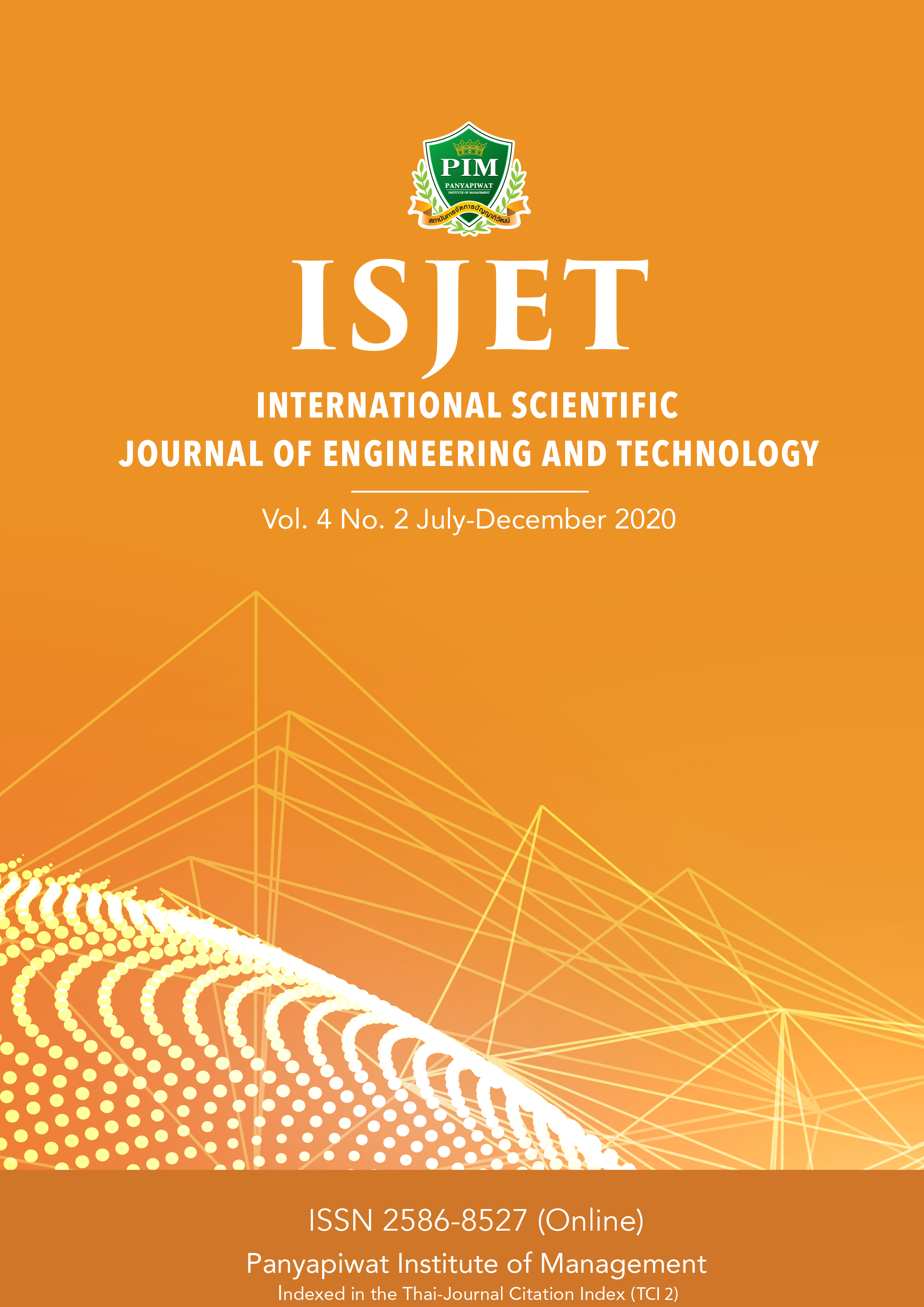A Simulation-based Optimization for Production Planning of Dedicated Remanufacturing System
Main Article Content
Abstract
This paper presents a study of a dedicated remanufacturing system using a simulation-based optimization approach. The remanufacturing system performs various rework processes such as inspection, assembly, disassembly, testing, and repair on used-products and transforms them to be as-new products. In this study, the original production line of this dedicated remanufacturing system is shared with multiple products and has a limited space to accommodate arriving used products. Therefore, an appropriate inventory capacity should be set and a proper switching rule should be introduced to set up the production line. Otherwise, excessive line switching time and cost would be incurred. The objective of this study is to sequentially improve and suggest a method to optimize the production planning of this dedicated remanufacturing system under uncertain conditions, i.e., uncontrollable product arrival and stochastic operational time. A case study is used to demonstrate and identify possible solutions, to show the advantages of the proposed approach. This approach can assist in decision making for the planning and management of remanufacturing systems.
Article Details

This work is licensed under a Creative Commons Attribution-NonCommercial-NoDerivatives 4.0 International License.
เนื้อหาข้อมูล
References
J. W. Ho, Y. S. Huang, and C. L. Hsu, “Pricing under internal and external competition for remanufacturing firms with green consumers, ” Journal of Cleaner Production, vol. 202, pp. 150-159, Nov. 2018.
J. Li, M. Gonzalez, and Y. Zhu, “A hybrid simulation optimization method for production planning of dedicated remanufacturing,” International Journal of Production Economics, vol. 117, no. 2, pp. 286-301, Feb. 2009.
R. H. Teunter and D. Vlachos, “On the necessity of a disposal option for returned items that can be remanufactured,” International Journal of Production Economics, vol. 75, no. 3, pp. 257-266, Feb. 2002.
X. Xia, K. Govindan, and Q. Zhu, “Analyzing internal barriers for automotive parts remanufacturers in China using grey- DEMATEL approach,” Journal of Cleaner Production, vol. 87, no. 1, pp. 811-825, Jan. 2015.
M. Fathi, F. Zandi, and O. Jouini, “Modeling the merging capacity for two streams of product returns in remanufacturing systems,” Journal of Manufacturing Systems, vol. 37, no. 1, pp. 265-276, Oct. 2015.
C. D. White, E. Masanet, C. M. Rosen, and S. L. Beckman, “Product recovery with some byte: An overview of management challenges and environmental consequences in reverse manufacturing in the computer industry,” Journal of Cleaner Production, vol. 11, no. 1, pp. 445-458, Jun. 2003.
V. Daniel and R. Guide Jr., “Production planning and control for remanufacturing: Industry practice and research needs,” Journal of Operations Management, vol. 18, no. 1, pp. 467-
, Jun. 2000.
C. C. Fang, M. H. Lai, and Y. S. Huang, “Production planning of new and remanufacturing products in hybrid production systems,” Computers & Industrial Engineering, vol. 108, pp. 88-99, Jun. 2017.
H. F. Wang and Y. S. Huang, “A two-stage robust programming approach to demand-driven disassembly planning for a closed-loop supply chain system,” International Journal of Production Research, vol. 51, no. 8, pp. 2414-2432, Apr. 2013.
N. Shabanpour and M. Colledani, “Integrated workstation design and buffer allocation in disassembly systems for remanufacturing,” Procedia CIRP, vol. 69, pp. 921-926, Nov. 2018.
J. Y. Lee, C. L. Chen, T. L. Wen el.al., “Synthesis and design of chilled water networks using mathematical optimization,” Applied Thermal Engineering, vol. 58, no. 1-2, pp. 638-649, Sep. 2013.
N. Tahirov, P. Hasanov, and M. Y. Jaber, “Optimization of closed-loop supply chain of multi-items with returned subassemblies,” International Journal of Production Economics, vol. 174, pp. 1-10, Apr. 2016.
K. Nuamchit and N. Chiadamrong, (2019, Jun.). Optimal inventory control policy of a hybrid manufacturing- remanufacturing system using a possibilistic linear programming approach. International Scientific Journal of Engineering and Technology [Online]. 3(1). pp. 41-59. Available: https://ph02.tci-thaijo.org/index.php/isjet/article/ view/199035/
D. E. Mazzuco, A. M. C. Danielli, D. L. Oliveira, et. al. (2018).
A concept for simulation-based optimization in vehicle routing problems. IFAC-Papers On Line [Online]. 51(11). pp. 1720-1725. Available: https://www.sciencedirect.com/ science/article/pii/S2405896318313296
Y. Chu, F. You, J. M. Wassick, and A. Agarwal, “Simulation- based optimization framework for multi-echelon inventory systems under uncertainty,” Computers and Chemical Engineering, vol. 73, no. 2, pp. 1-16, Feb. 2015.
B. Keskin, S. Melouk, and I. Meyer, “A simulation- optimization approach for integrated sourcing and inventory decisions,” International Journal of Computers and Operations Research, vol. 37, no. 9, pp. 1648-1661, Sep.2010.
W. Jie and L. Li, “Simulation for constrainted optimization of inventory system by using Arena and OptQuest,” in Proc. 2008 International Conference on Computer Science and
Software Engineering, 2008. pp. 202-205.
A. Sadeghi, G. Suer, R. Y. Sinaki, and D. Wilson, “Cellular manufacturing design and replenishment strategy in a capacitated supply chain system: A simulation-based analysis,” Computers & Industrial Engineering, vol. 141, pp. 1-22, Mar. 2020.
V. D. R. Guide, M. E. Kraus, and R. Srivastava, “Scheduling policies for remanufacturing,” International Journal of Production Economics, vol. 48, no. 2, pp. 187-204, Jan. 1997.


